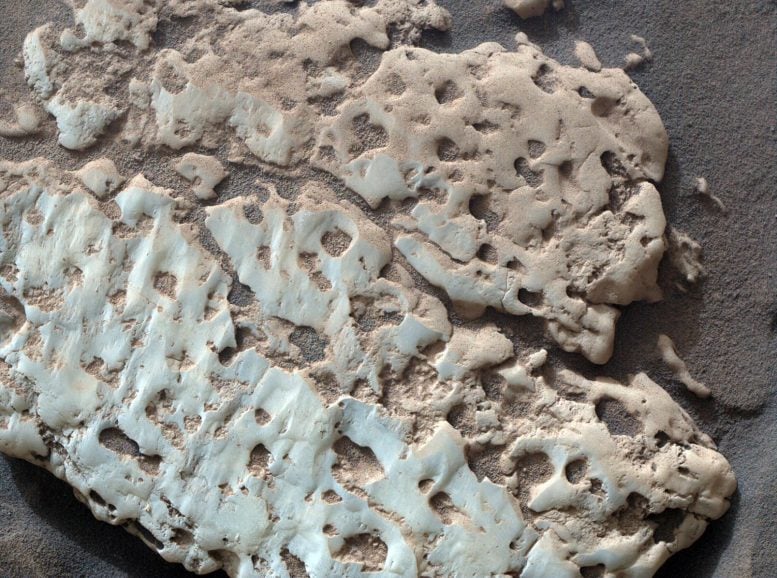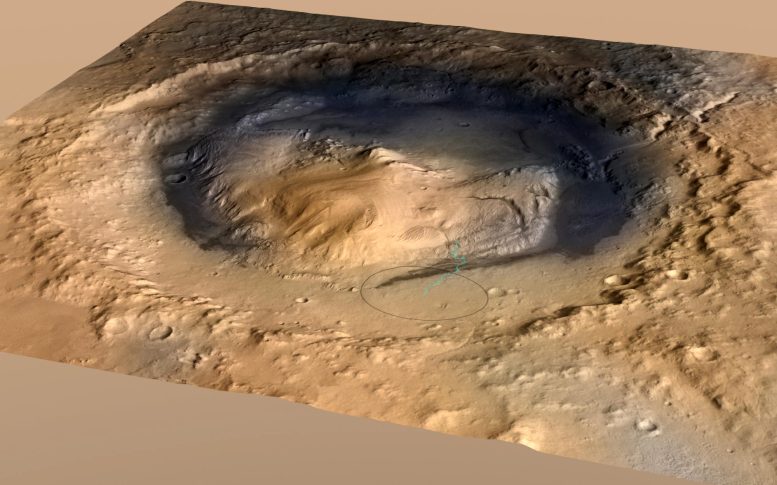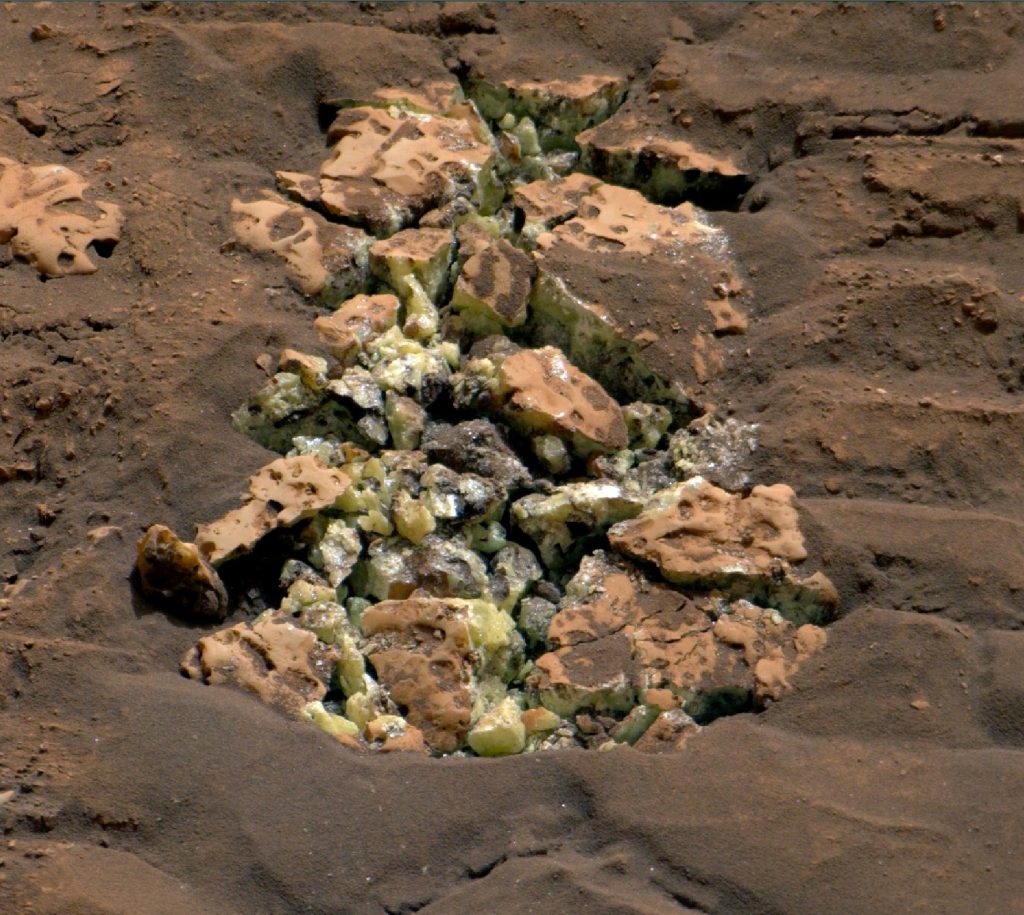These yellow crystals were discovered after NASA’s Curiosity rover accidentally drove over the rock on May 30, cracking it open. Scientists then used an instrument mounted on the rover’s arm to confirm that the crystals were elemental sulfur. This is the first time this type of sulfur has been found on the Red Planet. Credit: NASA/JPL-Caltech/MSSS
Among several recent discoveries, the rover has found rocks made of pure sulfur, a first for Mars.
National Aeronautics and Space Administration (NASA)Curiosity Mars The rover recently discovered yellow sulfur crystals in Martian rocks, revealing the presence of pure sulfur in an area known for sulfates. The unexpected discovery occurred while exploring a channel in Gediz Canyon on Mount Sharp that has been linked to ancient water courses and the potential for microbial life. The discovery raises new questions about the geological history and conditions of Mars.
Unprecedented discovery on Mars
On May 30, scientists were astonished when a rock passed by NASA’s Mars rover Curiosity broke apart, revealing yellow sulfur crystals never before seen on Mars.
Since October 2023, the rover has been exploring the Martian region. High in sulfatesIt’s a type of salt that contains sulfur, and it forms when water evaporates. But whereas previous detections of sulfur-based minerals, or mixtures of sulfur with other substances, have been successful, the rock Curiosity recently cracked is made of elemental sulfur, or pure sulfur. It’s not clear what relationship, if any, elemental sulfur has to other sulfur-based minerals in the area.
While many people associate sulfur with the smell of rotten eggs (from hydrogen sulfide gas), elemental sulfur is odorless. Sulfur only forms under certain conditions, and scientists haven’t linked it to the site’s history. And Curiosity found a lot of it: a patch of bright rocks similar to the boulders the rover crushed.

NASA’s Curiosity captured a close-up image of the rock nicknamed “Snow Lake” on the 4,209th Martian day of its mission, June 8, 2024. Nine days earlier, the rover had crushed a similar rock, revealing its internal crystalline structure and elemental sulfur. Credit: NASA/JPL-Caltech/MSSS
“Finding a rock block made of pure sulfur is like finding an oasis in the desert,” said Ashwin Vasavada, Curiosity project scientist at NASA’s Jet Propulsion Laboratory in Southern California. “It can’t be there, so you have to explain it. Discovering strange and unexpected things is what makes planetary exploration so exciting.”
This was one of several discoveries the rover made while driving off-road through Gediz Canyon, a channel that winds down part of the 3-mile-high (5-kilometer-high) Mount Sharp (see image below) as the rover drives along its base. On the rise since 2014Each layer of the mountain represents a different era in Martian history, and Curiosity’s mission is to investigate when and where the planet’s ancient terrain may have provided the nutrients needed for microorganisms to form on Mars, if they ever did.

Mount Sharp rises about 3.4 miles (5.5 kilometers) above the floor of Gale Crater. This oblique view of Mount Sharp was created by combining altitude and image data from three Mars rovers. The view looks toward the southeast. Gale Crater is 96 miles (154 kilometers) in diameter. Credit: NASA/JPL-Caltech/ESA/DLR/FU Berlin/MSSS
Floods and avalanches
The Gediz Canyon strait, discovered from space years before the launch of Curiosity, is one of the main reasons the science team wanted to visit this part of Mars: Scientists believe the strait was carved out by flows of liquid water and debris. Rock and Sediment Ridge It stretches across two miles of mountainside below the channel. The goal is to better understand how this landscape changed billions of years ago, and although recent clues are helping, there is still much to learn from this dramatic formation.
Since Curiosity arrives on the channel Earlier this year, scientists studied whether the giant piles of rubble that rose from the bottom of the channel were formed by ancient floods or landslides. Curiosity’s latest clues suggest that both played a role. Some of the piles appear to have been left behind by powerful flows of water and debris, while others appear to be the result of more localized landslides.
Pan around this 360-degree video to explore the Gediz Canyon strait, where NASA’s Mars rover Curiosity discovered sulfur crystals and drilled its 41st rock sample. The images that make up this mosaic were captured by the rover’s MastCam in June. Credit: NASA/JPL– California Institute of Technology/MSSS
These conclusions are based on the rocks found in the debris middens: while stones carried by water currents are rounded like river stones, some of the debris middens are littered with more angular rocks that appear to have been deposited by dry avalanches.
Eventually, water seeped into all of the material that had been deposited here. Chemical reactions caused by the water bleached white “halo” shapes into some of the rocks. Erosion by wind and sand revealed these halo shapes over time.
“This has not been a quiet period on Mars,” says Becky Williams, a scientist at the Planetary Science Institute in Tucson, Arizona, and deputy principal investigator for Curiosity’s Mast Camera (MastCam). “There’s been a lot of activity here. We’ve seen multiple flows through the channels, including active floods and rocky flows.”

NASA/JPL-Caltech/MSSS NASA’s Mars rover Curiosity captured this image of a waterway in Gediz Canyon on March 31. The area appears to have been formed by a large amount of water and debris building up into a mountain within the waterway.
Credit: NASA/JPL-Caltech/MSSS
Hole 41
This evidence of water continues to tell a more complicated story than the team originally anticipated, and they were eager to retrieve rock samples from the channel to learn more. And on June 18, their opportunity arrived.
The sulfur rocks were too small and brittle to drill into and extract samples from, but a large boulder nicknamed “Mammoth Lakes” was found nearby. The rover’s engineers had to find a section of rock they could safely drill into and find a parking space on the gently sloping surface.
After Curiosity dug its 41st hole using a powerful drill on the end of the rover’s 7-foot (2-meter) robotic arm, scientists on board the Six Wheels placed small amounts of powdered rock into onboard instruments for further analysis that will help scientists determine what material the rock is made of.
Curiosity then left Mammoth Lakes to see what other surprises awaited in the waterways.
About NASA’s Curiosity Rover
NASA’s Curiosity rover, officially called the Mars Science Laboratory (MSL), is a car-sized robotic rover that landed in Gale Crater on Mars on August 6, 2012. Its primary mission is to study the Martian climate and geology, in particular to determine whether Mars has ever had an environment suitable for microbial life. Equipped with a suite of scientific instruments, Curiosity can take panoramic images, analyze mineral composition, monitor environmental conditions, and drill into Martian rocks to collect samples.
Since landing, Curiosity has made important discoveries, including evidence of ancient flowing water that suggests Mars may have once hosted life. Managed by NASA’s Jet Propulsion Laboratory (JPL), the rover embodies advanced technologies gained from previous Mars exploration missions, improving its ability to navigate and survive the planet’s harsh environment. Curiosity continues to transmit valuable data back to Earth, greatly expanding our understanding of Mars.


